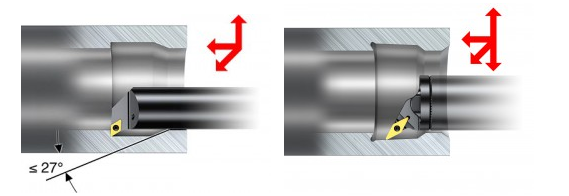Internal turning operation
Machining the inner diameter of the workpiece by internal turning operation. Long time overhangs and poor chip evacuation are two of the challenges with internal turning operation. Long time overhangs can cause problems like deflection and vibrations. Vibrations and poor chip evacuation can cause insert breakages. Difficulties with chip evacuation can also lead to poor surface finish.
The basic application areas for internal turning operationare longitudinal turning operation(1), and profile turning operation (2).
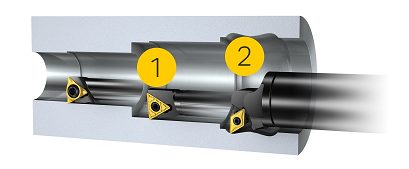
Longitudinal turning, one way of internal turning operation
The choice of tool is very much restricted by the component hole diameter and length (the depth of the hole with overhang). A general rule is to select a tool with the shortest overhang and the largest possible tool size.
Selecting the right tool for the operation, applying it correctly and clamping it properly all have an effect on minimizing tool deflection and vibration.
Insert shape
In internal turning operation, it is helpful to use positive basic-shape inserts as they have lower cutting forces compared to negative inserts. A small nose angle, as well as a small nose radius, also helpful to reduce cutting forces.
Entering angle
The entering angle affects the direction and magnitude of axial and radial forces. A large entering angle (small lead angle) produces a large axial cutting force, while a small entering angle (large lead angle) results in a large radial cutting force. An entering angle close to 90° (0° lead angle) and never less than 75° (15° lead angle) is recommended.
Tool holder
If there is a shoulder need to be machined in the component, choose a tool with 91–95° entering angle (-1 to -5° lead angle). It is recommended to use a triangular or a D-style (55°) insert.
If a stronger edge is needed, choose a C-style (80°) insert.
If there is no shoulder to be machined and the conditions are stable, increase productivity by using a square insert at 75° entering angle (15° lead angle).
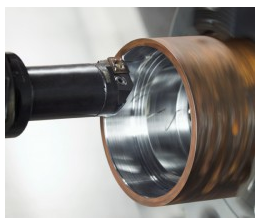
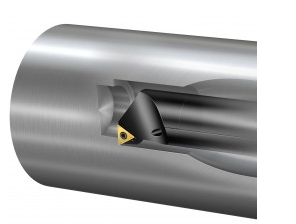
Profile turning, another way of internal turning operation
In internal profiling, the tool is exposed to both radial and tangential cutting forces. The radial cutting forces will deflect the tool away from the workpiece and the tangential forces will force the tool downwards and away from the centerline.
When boring small-diameter holes, it is particularly important that the clearance angle of the insert is high enough to avoid contact between the tool and the wall of the hole.
Insert shape
In profile turning the cut can vary as cutting depth, feed, and speed. The largest suitable nose angle on the insert should be selected for strength, cost efficiency, and accessibility. The most frequently used nose angles are 55° and 35°.
Entering angle
Entering angle and insert nose radius are both important factors for accessibility. The workpiece profile has to be analyzed in order to select the most suitable copying angle.
A free cutting angle of at least 2° between workpiece and insert has to be maintained. However, for reasons of surface finish and tool life, at least 7° is recommended.
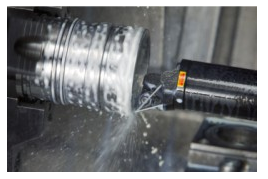
Tool holder
The first choice is a tool with 93° entering angle (-3° lead angle) and a D-style (55°) insert. If a larger ramping angle is needed, use a V-style (35°) insert.
For the possibility to profile the face or to make a corner relief, choose a holder with a 107–117° entering angle (-17 to -27° lead angle).
There are specific tools for back boring, specially designed to machine a shoulder in the opposite direction.
